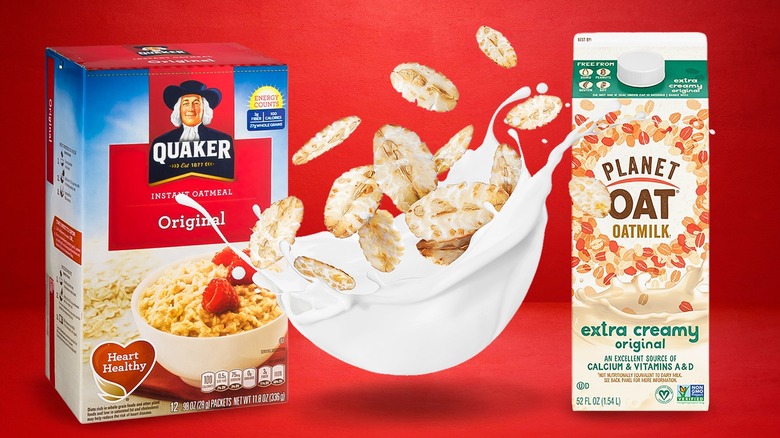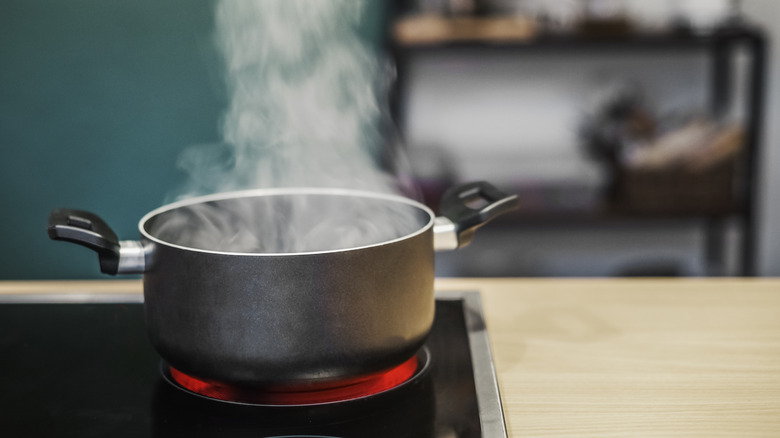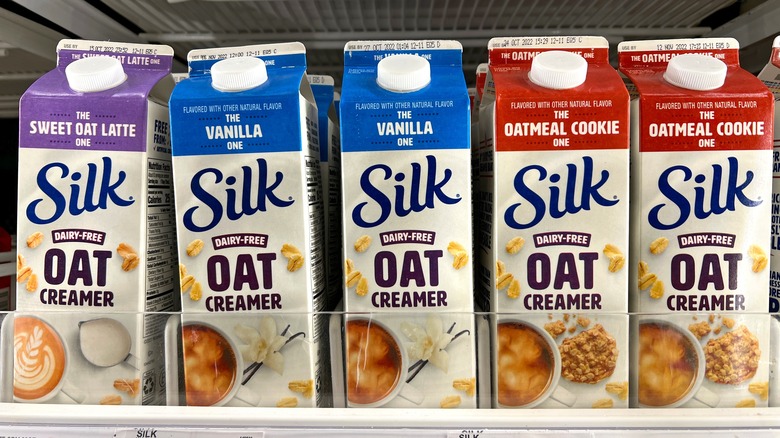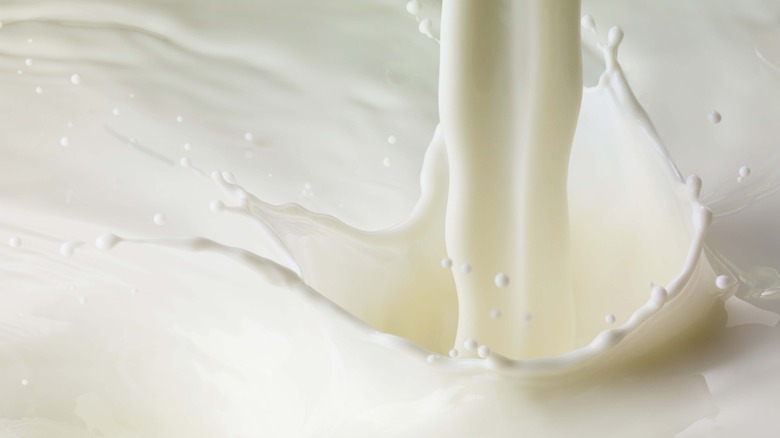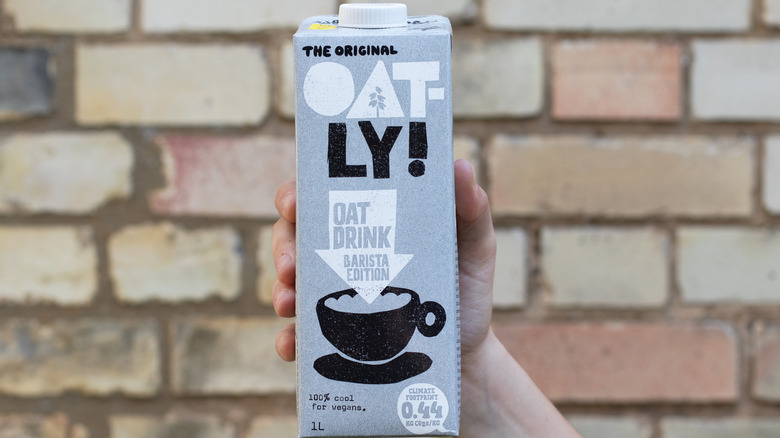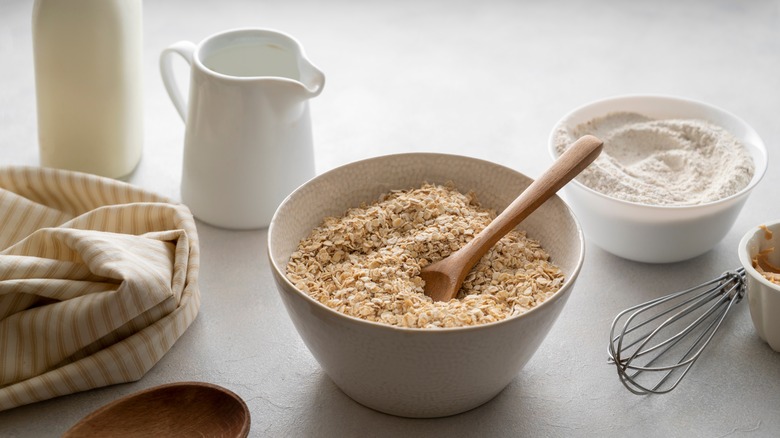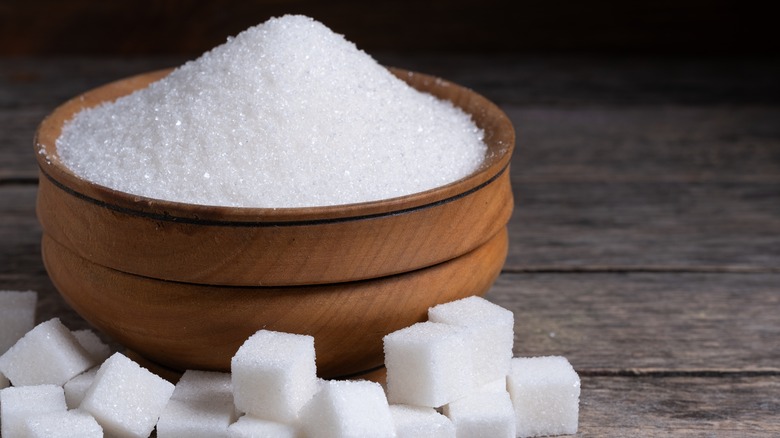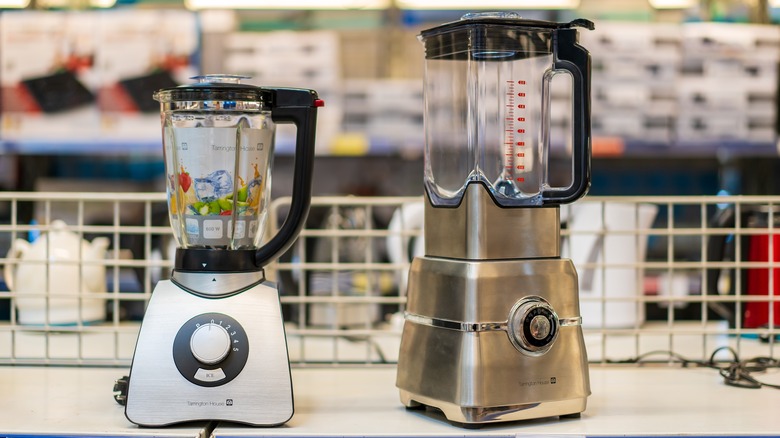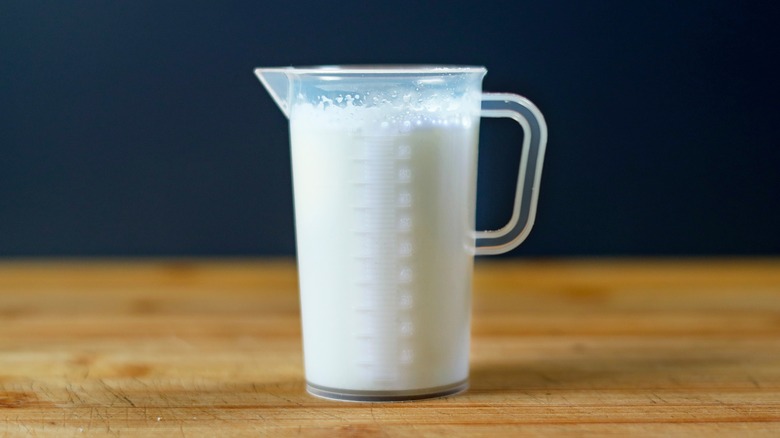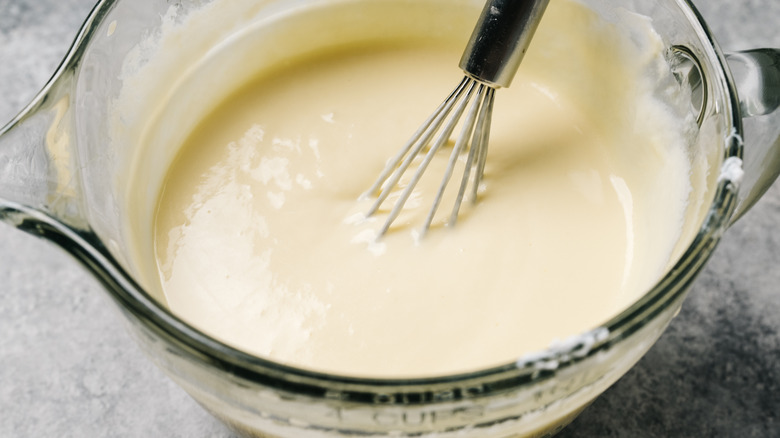10 Mistakes To Avoid When Using Oat Milk
With dairy milk falling out of favor amidst the rise of veganism, plant-based milk alternatives have finally seized the limelight, with a whole host of different varieties and flavors hitting the shelves. Indeed, there seems to be more choice of plant-based milk now than there ever was, and there are certainly more types than with regular old milk. So then the challenge becomes: How do we choose which milk to adopt, and more to the point, how do we use it?
Oat milk is an especially strong contender in the plant-based milk market because of several factors. First of all, after the oats are blended with water and the mixture is strained, the texture that emerges is very similar to dairy milk, and according to Tasting Table recipe developer Taylor Murray, who has contributed her expert insight to this article, the two also have the same moisture content. Second, oat milk is one of the more sustainable options, as oats require less water to grow than almonds and some other ingredients used to make milk alternatives. Lastly, oat milk doesn't seem to offend as many people's allergies as it is among the few types of plant-based milks that doesn't contain nuts (as with almond milk) or soy. Even so, oat milk is not foolproof, and it is possible to make a mistake while using such a rarified ingredient. Let's take a look at some of them here.
Using warm water to make it at home
Unlike dairy milk, which requires cows, oat milk can be made at home without giving up your life to the farm. This is a relatively simple process involving blending oats and water together to create a creamy mixture that then gets strained through cheesecloth to remove any chunky oats and keep the milk creamy and smooth. But as simple as this seems, there is something that can go horribly wrong somewhere along the way: Your homemade oat milk could get slimy, and no one wants to drink slimy milk.
This effect is caused by the excess of starches that form in the milk as you prepare it, and it's often caused by the use of water at too high a temperature. Luckily, all you have to do to avoid this potential debacle is use ice-cold water. In fact, you might want to take the extra step of placing some water in the fridge a few hours before you want to make your oat milk to ensure your second most important ingredient is ready to go. In a similar vein, make sure you also don't overblend your oats, as this can also cause the milk to heat up despite your best intentions to keep it cold.
Choosing the wrong brand
As with any kind of product, not all oat milks were created equal. Although all brands use a similar set of ingredients, the proportions, techniques, and quality of the prime materials can differ. This is why it's important to be discerning when picking out a brand of oat milk to use for your next recipe.
Luckily, you won't have to start your search from scratch. We just so happen to have a ranking of the best oat milk brands on the market, and our suggestion is to start here. But broadly speaking, there are a few things to look out for when you make your choice. First, go for an oat milk that is on the creamy side and not so watery, especially when using the product as a dairy milk substitute, as this will ensure the closest similarity in texture and moisture content. You may also want to stay away from oat milks that come with too much added sugar, as this will alter the overall flavor of whatever you're trying to make.
Mixing it with other ingredients at different temperatures
Baking with oat milk can be a very rewarding experience. If you're vegan, lactose intolerant, or simply want to move away from dairy, oat milk makes a great substitute in many recipes. As Tasting Table recipe developer Taylor Murray notes, oat milk is a no-brainer because, in most recipes, it can be used in a 1:1 ratio in place of dairy milk.
But that doesn't mean it's infallible. While many people know that mixing milk and lemon can easily cause curdling, not everyone is aware that oat milk can curdle, too, especially when it is added to a very hot substance that is more acidic, like tea or coffee. This happens because applying heat to oat milk causes its proteins to break down and separate, which is where the curdling comes in. Avoiding this scourge can be achieved with a simple extra step: Be sure to heat your oat milk to the same temperature as the other ingredient you want to mix it with. If that can't be achieved, try to add heated-up oat milk to a cooler liquid while whisking constantly — this will give the two liquids time to reach a similar temperature in the same amount of time. Alternatively, you can allow your coffee to cool before pouring in the oat milk for your coffee layer cake.
Forgetting to shake it
While cow's milk tends to maintain a uniform consistency when in liquid form, this is not necessarily the case with many plant-based milks, including oat milk, and especially when it's homemade. Indeed, no matter how much oat milk is blended and filtered, either at home or on the production line, a few microscopic bits of oats are likely to remain, and since these are heavier than water, they can settle at the bottom of a container. To avoid ending up with a carton of tiny bits of oats and no milk to speak of, it's important to shake that carton before each use.
Not shaking the container also means you'll be more likely to have to deal with that dreaded watery oat milk consistency that put so many people off plant-based milks when they first came on the market (and hadn't yet perfected the recipe for commercial exploitation). Those microscopic bits of oats are what help oat milk maintain a consistency that is similar to cow's milk, so you're going to want to make sure they've involved in each portion of oat milk you pour.
Paying too much attention to the expiration date
The expiration date on your oat milk carton may seem like something that is far into the future — a problem for another day. But once that carton is opened, you should know that all bets are off. Indeed, expect oat milk to only last for about five to seven days in the fridge once opened, not unlike cow's milk. This is true of both shelf-stable oat milk found in the grocery store aisles and the refrigerated kind.
A problem may arise when you can't for the life of you remember when you opened that carton. Was it two days ago or 10? Time flies when you're having fun, and it's hard to keep track of each and every ingredient that is camping out in your fridge. Luckily, there's a trick for figuring out whether your oat milk has gone bad before you ruin your baking project with sour milk. Simply bring your nose to the opening of the milk carton and check whether the liquid has an acrid or sour smell, or whether it still emits a sweet aroma. Just as with cow's milk, sour smells mean the liquid has gone bad. Similarly, a yellowish and chunky consistency indicates spoilage in both oat and cow milks.
Using instant oats to make homemade oat milk
Making homemade oat milk is easier to do than you might expect, and it may be beneficial if you use it on a daily basis and want to cut your budget some slack. That said, you should know that you can't use just any kind of oat when making homemade oat milk. Of the three main types commonly found on shelves — steel-cut oats, rolled oats (or old-fashioned oats), and quick-cooking oats or instant oats — it is imperative that you do not use instant oats to make oat milk. Quick-cooking oats are designed to cook faster, as the name suggests, which is achieved by making them thinner and by par-cooking them at length before packaging. This makes them able to absorb liquids more quickly–and therein lies the problem: Quick-cooking oats (and instant oats) absorb water so quickly that they tend to oversoak in no time, causing that dreaded oat milk slime.
Solve this problem by simply sticking to rolled oats. Although they are also par-cooked before packaging, it's not to the same extent as quick-cooking oats. Meanwhile, steel-cut oats, which are the least processed type, tend to make less creamy milk.
Choosing an oat milk with added sugar or flavoring
As Taylor Murray notes, "Cow's milk does not have any added flavoring, so using an oat milk that has that is going to skew your recipe." Instead, she recommends using an oat milk that is as similar as possible to the flavor of dairy milk, and if you must, you can add flavoring from there, staying in control of how much or how little goes in. It stands to reason, then, that it's best to avoid oat milk with any added sugar or flavoring, especially when you're planning on adding it to a recipe that doesn't specifically call for that type of beverage.
Sugar can be especially pesky in this situation. While unsweetened oat milk tends to have some amount of natural sugars, as does cow's milk, added sugar can mess with the overall sugar content in your cake recipe, and since baking is all about chemistry, this could end up affecting not only the flavor but also the texture and crumb. As for your health, remember that a lot of foods already contain added sugars, and there's not much you can do about it. Since the American Heart Association suggests you limit added sugar consumption to no more than 6% of your calories per day, oat milk is one place where you can easily cut back, if you so wish, just by checking the label on your carton.
Making homemade oat milk with the wrong tools
While it may be fairly easy to make homemade plant milk, mistakes can be made, especially if you don't have the right tools to do so. In short, there is no embarking on this endeavor if you don't have a working blender or the right material to use as a filter. The blender is key because you will need to blend those oats with water until they turn into a pulp. This may be a short step, but you can't proceed to the next one without it.
Finally, you'll need to strain the blended oats to create that smooth, creamy texture we all love so much. For best results, you might want to double-strain them through a fine-mesh sieve to remove the chunkier bits of oats (blenders are great, but they're not magic). Then, strain it all again through a cheesecloth. Alternatively, you can strain the milk through a mesh sieve twice or as many times as you deem appropriate. Either way, it looks like you're going to need a sieve if you want to make a proper batch of homemade oat milk.
Not getting the ratios right when using oat milk as a dairy substitute
Although, in many cases, oat milk can be substituted 1:1 for cow's milk, there are some caveats to this golden rule. "They are both liquids and have a similar amount of fat," says Taylor Murray, "but cow's milk contains specific proteins only found in cow's milk, mainly whey and casein. Those ingredients can make a huge difference when baking or cooking, but it depends on the recipe and what role the milk is playing in it."
This means paying close attention to your recipe. For sweet no-bake recipes like custards, mousses, and ganache, where the 1:1 ratio works well, start by using a high-fat or extra creamy oat milk, which most closely resembles the whole milk typically called for in these recipes. For baked goods, it's important to find an even stronger source of fat. Dairy and its high fat content helps give many baked goods that coveted golden finish, which is something oat milk-based baked goods lack. To fix this problem, in addition to substituting oat milk for cow's milk, you can add a tablespoon of butter (or oil if you want this to be completely dairy-free) per cup of oat milk. At the end of the day, the golden ratio in baking is not so much whether you've used the same amount of oat or cow's milk, but whether the fat content is comparable.
Using oat milk to make cheese or custard
Oat milk is a popular choice to add to coffee, tea, and baked goods, but it can be a little finicky to use in other recipes, such as when making cheese or custard. According to Taylor Murray, many people make the mistake of "expecting [oat milk] to be able to make cheese or custards the same way that cow's milk would," and this simply just won't happen. They each contain different kinds and amounts of proteins, which means the coagulation process necessary to create these delights will function differently.
More specifically, you may need to give yourself some extra time to wait for an oat milk mixture to thicken when making custard, or it may be necessary to include additional ingredients, such as xanthan gum to your cheese mixture after culturing. This will help the cheese thicken and remain as solid as possible, even as you grate it onto your tacos or pasta.
